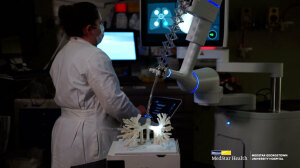by
John R. Fischer, Senior Reporter | March 09, 2022

MedStar Georgetown University Hospital has a new approach that enables patients to be diagnosed and treated for lung cancer in the same day
MedStar Georgetown University Hospital is the first in its region to diagnose and treat lung cancer in the same day.
A team of pulmonary and thoracic experts utilized Combined Robotic Assisted Thoracic Surgery (CRATS) to diagnose tumors with low-dose CT in high-risk lung cancer patients, assess for possible spread of cancer and extract the malignant parts of the lung.
The team used the DaVinci robotic video-assisted thoracic surgery system to remove the tumors and says the approach limits the risk of the disease spreading and allows patients to begin additional therapies sooner. In some cases, it can also cure cancer. "Given the impact of lung cancer — the leading cause of cancer deaths — this is a major step toward stopping the disease in its tracks, resulting in better outcomes and giving patients an improved chance at life,” said Dr. Eric Anderson, director of Interventional Pulmonology at MedStar Georgetown University Hospital, in a statement.




Ad Statistics
Times Displayed: 30380
Times Visited: 760 Stay up to date with the latest training to fix, troubleshoot, and maintain your critical care devices. GE HealthCare offers multiple training formats to empower teams and expand knowledge, saving you time and money
Typically diagnosing and treating a patient takes several weeks, which can be enough time for cancer to continue to grow, thereby making a patient’s prognosis worse and increasing their anxiety.
Under CRATS, tumors are identified in high-risk lung cancer patients with low dose CT and a real-time biopsy is performed to determine if the lumps are cancerous. If they are, an endobronchial ultrasound is performed to determine if the cancer has reached the lymph nodes. If it has not, the patient undergoes surgery the same day to remove the part of the lung with the cancer.
Diagnosis is carried out by the Ion endoluminal, a minimally invasive robotic-assisted system designed by Intuitive. With it, surgeons can reach the peripheral nodules in the lungs to diagnose cancer and obtain tissue samples from deep within the organs.
Additionally, the solution offers real-time guidance for improved accuracy and can navigate through small airways to reach nodules in any airway segment of the lung with its flexible biopsy needle. The needle passes through small bends to collect biopsy tissue, while the catheter’s 2 mm working channel allows for additional biopsy options, including biopsy forceps and cytology brushes. Its fiber optic shape sensor technology provides the precise location and shares information about the catheter throughout the process.
These capabilities, combined with regular screening for high-risk patients, make the system more accurate at detecting cancer earlier, especially for small nodules, say the researchers.
"Millimeters matter," said Anderson. "We know that the earlier we find the nodule in the lung and the smaller it is, that has the greatest impact on mortality. If we find the nodule at 1 mm, there is a 90% chance of survival. At 2 mm, there is 80% and at 3 mm, 70%. Combine those odds with the potential immediate removal of the tumor, and the Ion robot gives patients a real chance for better outcomes."

